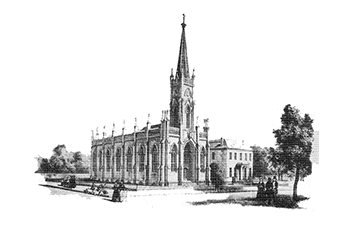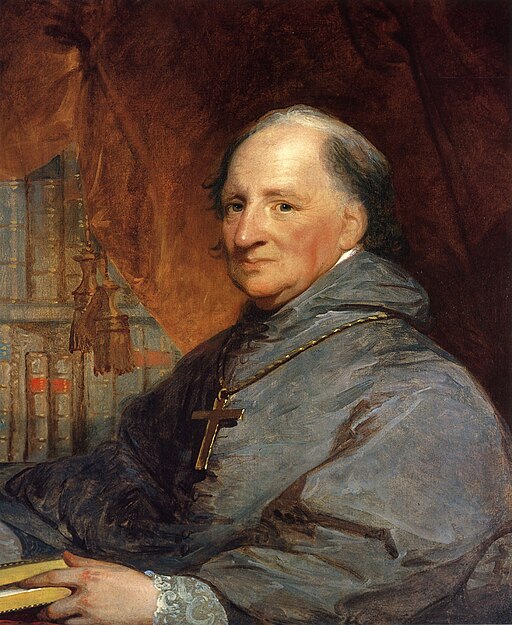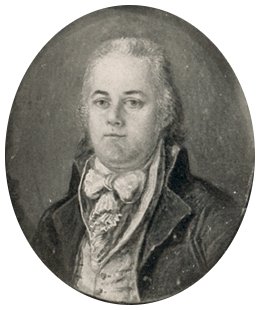Timeline 1714 –1837
French Period: 48 Years
1714
French explorers found Natchez and build the first Catholic church on plateau below Fort Rosalie and above the river landing.
1729
November 28: Natchez Indians attack Fort Rosalie and kill 150 men, 36 women, and 56 children. Among the dead were "(The Reverend Father) Poisson, Jesuit missionary", and "Francois Dubrey, Sacristan".
1762
Louis XV cedes Louisiana territory west of the Mississippi to King Carlos III of Spain.
English Period: 16 Years
1763
The Treaty of Paris cedes French territory east of the Mississippi River to England.
1776
Americans revolt against England.
Spanish Period: 19 Years
1779
Spain takes control of the Natchez territory.
1783
Treaty of Paris ends the American Revolution, but Natchez is caught between the United States on the east and Spain on the west of the Mississippi River.
1787
August: Three priests arrive in New Orleans from the Royal College of Irishmen at the University of Salamanaca. The bishop of New Orleans assigns Fathers Mckenna and William Savage to Natchez and Father Gregory White to Coles Creek.
1788
March 21: The fire on Good Friday in New Orleans destroys St. Louis Cathedral and the church records.
April 11: Property is purchased on Commerce Street in Natchez (center of town).
1789
Gayoso Don Carlos de Grand Pre becomes governor of territory.
July 14: French Revolution--Church in turmoil and persecution.
November 6: Father John Carroll appointed first bishop of Baltimore and of the United States.
1790
Natchez town plan ordered by Gayoso and designed by Jean (John) Girault; the Church of San Salvador del Mundo built on Commerce Street.
1791
St. Mary’s Seminary is founded in Baltimore by Sulpician fathers.
1793
April 18: Father William Savage (Irish priest) dies in Natchez after six years of service.
1794
Father Francisco Lennan, pastor, and John Brady, O.D.C., assistant, until 1797.
February14: Luis Penalver Y. Cardenas appointed bishop of New Orleans by royal decree.
1795
July 24: Bishop Cardenas arrives in New Orleans.
October 4: John Joseph Chanche is born to John and Catherine Provost Chanche in Baltimore, Maryland.
October 27: Treaty of San Lorenzo (Spain cedes Mississippi territory to United States).
1796
Bishop Cardenas visits the Catholics in Natchez from May 5 to May 16.
June 17: Father Gregory White leaves Coles Creek after nine years.
1797
March to July 1800: Father Paul of St. Peter, O. C. D. serves Natchez. Dies at St. Gabriel, Louisiana, 1826.
1798
August: United States Governor Winthrop Sargeant arrives to govern the Natchez territory. He lives at Concord, the home of Spanish Governor Gayoso.
Territory survey begun by Andrew Ellicott for the United States and by William Dunbar for Spain.
1799
April 4: Bishop Cardenas resigns his office in New Orleans.
1800
October 1: Treaty of San Ildefonso (Spain sells New Orleans, Louisiana, to France).
1802
January 7: The Roman Catholic Society pays $500 to William Barland for the church, San Salvador del Mundo, on Commerce Street and property on Main and Union Streets. (The church was not incorporated to own land under the United States until 1818.)
February 10: Bishop Cardenas becomes archbishop-elect of Guatemala. Appoints Father Thomas Hassett "ruler of his diocese”, and Father Patrick Walsh, his assistant.
November 9, to May 1803: Father Henry Boutin is in Natchez. He is asked by Father Hassett of New Orleans to accompany sixteen Ursuline nuns to Havana as they preferred to "stay under Spain.” Afterwards Father Boutin is sent to Baton Rouge. He dies in France in 1815.
1803
Napoleon Bonaparte by Treaty of Paris sells Louisiana territory to United States.
1806
St. Mary’s Seminary Chapel in Baltimore, the first neo-Gothic church in the United States, is begun.
July 7: Bishop John Carroll lays the cornerstone for the first cathedral in the United States.
1807
Territory of Mississippi established.
1809
Mother Elizabeth Ann Bayley Seton founds the Daughters of Charity of St. Joseph.
1811
John Joseph Chanche (later, first bishop of Natchez) enters St. Mary’s College in Baltimore, Maryland.
1812
Elizabeth Maria Celest Brooks of Natchez wills $1,000 to support a priest in Natchez if one could be obtained within three years.
1815
Bishop William Dubourg appointed to the diocese of New Orleans, which includes Mississippi to St. Louis, Missouri.
December 3: Archbishop John Carroll dies in Baltimore.
1817
Oct. 14: Manuel Garcia de Texada wills $1,500 to the Roman Catholic congregation if they organize within two years.
December 10: State of Mississippi is established.
1818
Mississippi legislature passes an act to incorporate the president and board of trustees of the Catholic Church.
1819
Father L. A. Chauderat arrives from Bardstown, Kentucky, and then goes to New Orleans to procure requisites for mass.
June 5: John Joseph Chanche ordained to the priesthood by Archbishop Marechal of Baltimore.
June 12: First mass said by resident priest since Spanish-appointed clergy departed.
December: Father Chauderat departs after Christmas for Arkansas.
1820
Father Anthony Blanc in Natchez from March to June. Born in France in 1792, he later becomes archbishop of New Orleans and supporter of Bishop Chanche.
1821
January 4: Mother Seton, foundress of the Daughters of Charity of St. Joseph, dies in Emmitsburg, Maryland.
May 21: Archbishop Marechal dedicates first cathedral in the United States, Assumption of the Blessed Virgin Mary, in Baltimore.
June: Father Constantine Maenhaut arrives in Natchez after his ordination in St. Louis, Missouri, and serves as pastor until January 1823.
1822
Natchez City Cemetery established north of town. Transferral of remains in the Spanish cemetery (now Memorial Park) begins.
Bishop Louis Dubourg of New Orleans administers Confirmation in Natchez with the assistance of Reverend M. Vidal, brother to Don Jose Vidal from Vidalia.
July: Mother Rose Philippine Duchesne of the Society of the Sacred Heart arrives with several companions on her way to New Orleans from St. Charles, Missouri. She is "heartily welcomed by Father Maenhaut." On her return trip to Natchez from New Orleans, yellow fever breaks out. ( Duchesne was canonized in 1988.)
1823
January: Father Maenhaut sent to New Orleans.
1824
November 1: Letter from Gabriel Gireaudeau concerning organ to be received from the bishop. A present from King Louis XVIII. The organ is said to have belonged to Louis XVI. (Gabriel Gireaudeau was a member of the Roman Catholic Society of Natchez and served as its president for a time.)
1825
April: Reverend Simon Gallagher arrives from New Orleans but dies on December 13, 1825, in Natchez at 69 years old.
1827
December 1: Gabriel Gireaudeau dies without a priest.
1828
March 24: Father Anthony Ganilh arrives from Baton Rouge to become pastor of San Salvador del Mundo Church.
May 1: The Roman Catholic Society of Natchez rents the under story of the church to J. J. Rowan & Company for a dry goods store.
1829
May: Father Ganilh departs.
1830
February 13: Announcement in the Natchez newspaper that Mass will be offered.
February 17: Father Leo DeNeckere is bishop-elect of New Orleans. He dies in 1833.
1831
Father Doyle is in Natchez for two consecutive Sundays.
1831-1835
Cornelia and Pierce Connelly in Natchez, staying at the White Cottage (now Twin Oaks). (See May 8,1838.)
1832
May 1: The under story of San Salvador del Mundo Catholic Church rented to Stockman and Phipps for a dry goods store.
December 28: The forty-year old Spanish church burns. The organ was lost, but smaller articles of the church were saved.
Father Adam Kindelon comes from New Orleans for a few months.
1834
Father A.P. Ladaviere signs himself as administrator of the diocese.
Reverend John Joseph Chanche, S. S. is president of St. Mary’s College in Baltimore until 1840.
1835
June 19: Father Blanc named bishop of New Orleans and consecrated on November 22.
The Connellys move to Grand Coteau, Louisiana. (Pierce Connelly was instrumental is obtaining Bishop Chanche’s chalice from Pope Gregory XVI in Rome.)
Grading of the Spanish cemetery to street level in preparation for construction of 1839 presbytery and future growth of the church in Natchez.
1837
July 28: Episcopal Diocese of Natchez established by Pope Gregory XVI at St. Mary Major in Rome along with those of Nashville and Dubuque, Iowa.
Father Thomas Heyden of Pittsburgh named first bishop of Natchez, but he refused the appointment.
Sources: Cradle Days of St. Mary’s at Natchez by Richard O. Gerow, bishop of Natchez; 1941 (reprinted 1985); St. Mary’s of Natchez: The History of a Southern Catholic Congregation, 1716-1988, Vols. I & II, by Charles E. Nolan, Ph.D., 1992; Letters of Francis Janssens, archbishop of New Orleans (formerly bishop of Natchez), in the archives of Notre Dame, Notre Dame University, South Bend, Indiana.





